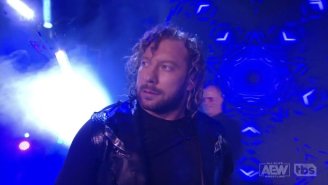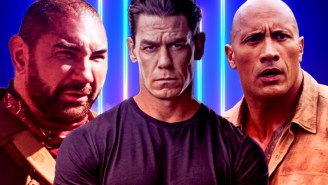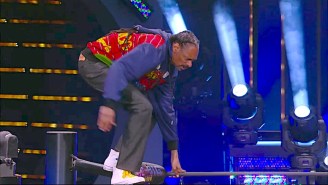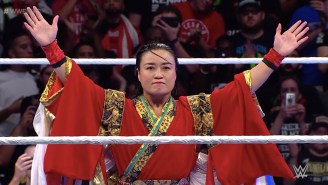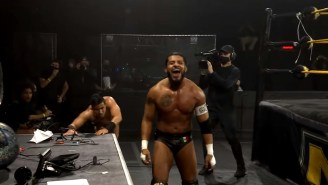In 1982, Jerry Lawler and Andy Kaufman appeared on Late Night with David Letterman. They couldn’t have known at the time, but this interview kickstarted a relationship between mainstream celebrities and pro wrestling that’s now heavily relied upon in modern televised pro wrestling.
Before he met Jerry Lawler, self-professed non-comedian and performance artist Andy Kaufman began incorporating wrestling into his nightclub act in Los Angeles. Inspired by the world of kayfabe and the over-the-top personalities of wrestling characters, Kaufman proclaimed himself as the “Inter-Gender Wrestling Champion of the World.” Night after night, he would bring out a mat and a referee (writing partner and best friend Bob Zmuda) and challenge women from the audience to a wrestling contest. Kaufman even went so far as to approach Vince McMahon, Sr. after a WWF show in New York, but, well… that didn’t quite go over so well.
Today, we know WWE as the place constantly clamoring for celebrity attention. There’s even an entire “wing” in the WWE Hall of Fame for celebrities, including Drew Carey, Mike Tyson, and Pete Rose. But back then, it proved nearly impossible to mix the two.
So Andy went to one of WWE’s shows in New York City and approached Vince McMahon Sr. with the idea of wrestling women out of the audience at an actual wrestling event. Andy felt like he wanted to get a crowd response from people that had actually come to see a wrestling show. My understanding is that Vince Sr. explained to Andy that, “Our fans are skeptical anyway, and I’m hesitant to involve a Hollywood actor in our wrestling show. I don’t want people to think that all of our wrestlers are actors.” So, he kind of nicely gave Andy the brush-off.
From a recent interview with Bob Zmuda:
When Vince McMahon started building the franchise of the WWF, Andy definitely had talked to Vince. We had gone to Vince McMahon and talked a few times about trying to get a bout between Jerry Lawler and Andy Kaufman but at that time Vince wanted to stay away from Hollywood and Andy wasn’t “Hollywood, he was the anti-hero. Vince didn’t realize Andy was an anti-Hollywood guy and it never happened. Which Andy had always wished that it did.
It was that initial rejection that led to Kaufman working with Jerry Lawler. Kaufman was introduced to Lawler by his friend, legendary wrestling journalist Bill Apter, who suggested that Kaufman work with Memphis territory icon Jerry “The King” Lawler.
Andy wanted to step in the middle of the ring, and challenge women. The first night that he did it, women came down, and we let the audience literally pick who Andy’s opponents were going to be. The next thing you know, we’ve got five women lined up, and we just rang the bell. Andy made some crazy comments beforehand. I think he offered $5,000 to any of the women that could beat him. It just got more ridiculous. He said to one woman, “If you can beat me, I’ll marry you!” Just crazy stuff. We drew a capacity crowd, a complete sellout. People came out to see the big TV star. I honestly believe that his intentions were to do just that one show and get it out of his system, but I saw dollar signs. So I said, “Andy that was great. We run a show here every week. You need to come back and do it again. We’ll really pump it up big on TV this Saturday.” And he said, “Really? I can come back and do it again?” And I said, “Of course!” – Jerry Lawler
From there, Kaufman would cut a series of promos on the city of Memphis itself, explaining things like what soap is, and how to properly use toilet paper. These aired on local NBC affiliate Channel 5 during the Saturday morning 90-minute wrestling show. These helped to whip wrestling audiences even further into an angry frenzy whenever Kaufman would appear. The viewing audience was so offended that they spent all week tying up the station switchboard, not just complaining about the promos, but threatening Andy and the station itself.
All of this build-up led to Kaufman and Lawler finally meeting in the ring. Kaufman prepared by sending along a promo from Hollywood, and wrestling a “327-pound woman” to show that he wasn’t afraid of Lawler and would wipe the floor with him. They finally came together in the now infamous match that resulted in Kaufman wearing a neck brace for months after the finish:
[protected-iframe id=”6d2ce4e0541a3c9ed93851858939c142-60970621-24613583″ info=”” width=”650″ height=”400″ frameborder=”0″ scrolling=”no” webkitallowfullscreen=”” mozallowfullscreen=”” allowfullscreen=””]
“When Andy was in the hospital, they had done X-Rays, and he had sprained his neck very badly. He was there for a number of days, and when they said he was going to be okay, they said, ‘Just watch your neck.’ Because he had a terrible sprain, and he could have had a broken neck, and I don’t think Jerry Lawler would have cared, and I think that Jerry was shocked he didn’t have a broken neck. Andy then wore a neck brace for the next six months. It made the papers all across the country, it was probably the biggest item that didn’t just make the theatrical pages, but it made the sports pages all across the country. It really took for the first time, professional wrestling, and really gave it its biggest hit yet. So, of course Letterman had seen this. He had Andy on the show many times, and his people called up Andy’s management and called up Jerry Lawler’s management and said, ‘Andy, would you be willing to go on David Letterman’s show and bury the hatchet with Jerry Lawler?’ So, we all went to New York,” Bob Zmuda said.
Initially, the interview was supposed to stick to two segments. They would start out by showing the promos and giving a backstory, and a clip of Lawler piledriving Kaufman. The two were supposed to have a brief, but joking confrontation, culminating in Kaufman apologizing for making fun of wrestling, and Lawler apologizing for hurting Kaufman’s neck. Then, Kaufman was going to stand and sing “What the World Needs Now.” That… is not how it went down.
“When neither one of us apologized, nor did Andy sing, Dave realized it was going south. So he said, ‘We’ll take another break and see if we can get things sorted out.’ I knew once we went to break, they were going to get rid of us. So, when Paul Shaffer’s band started playing music to break, I got up out of the seat, looked Andy in the eye, and slapped the taste out of his mouth. I slapped him as hard as I could. Knocked him right out of the chair. Paul Shaffer stopped playing the music, and the place just went silent. Everybody was just stunned. Dave had no clue what to do. He said later that was the first time he completely lost control of a show. It just shocked everybody,” Jerry Lawler said.
Though the “reality era” of wrestling has all but killed the idea of kayfabe (the suspension of disbelief when events are scripted or predetermined), this was the first time wrestling crossed over into the mainstream on such a grand scale while staying within those confines. Kaufman was known for loving the ideas of elaborate hoaxes, and that same principle is at the heart of what wrestling tries to accomplish. In fact, it wasn’t until the 1995 NBC special A Comedy Salute to Andy Kaufman that the whole thing was revealed as “a work” (a made-up angle played as real). In the end, Kaufman’s commitment to kayfabe ended up lasting for the rest of his life.
While the legacy David Letterman is vast, it’s pretty amazing to look back at what could have very well been just a near-forgotten footnote, and realize that without those few minutes on a late night talk show, wrestling simply would not be what it is today.
This is an updated version of an article that ran in May 2015

